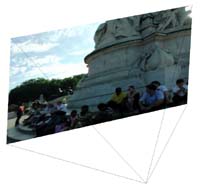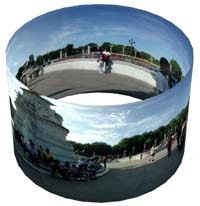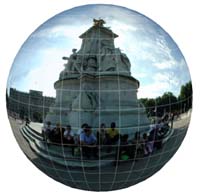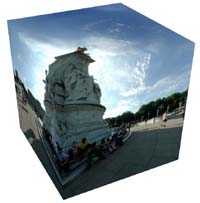Types of panoramic images
Source : Panoguide : http://www.panoguide.com/howto/panoramas/types.jsp
There are various types of panoramic image and various buzz-words used to describe them and the image formats used.
Planar or flat
 |
A planar or flat panorama |
Conventional photographs may be described as "flat"
or "planar", meaning that they are intended to be viewed as is without
any perspective correction.
Cylinder
 |
A cylindrical panorama |
Probably still the most common and popular format of panorama is the cylinder. A cylindrical panorama is intended to be viewed as if curved around the inside of a cylinder. If you view the image flat, you will see curves in the horizontal axis.
There are many Java applets and other viewers for displaying
panoramic images on the Internet which are designed to display cylindrical
panoramas as flat, i.e. without correcting perspective by displaying the image
as if you are looking at it inside a cylinder. These viewers display the horizontal
curves.
Sphere (equirectangular format image file)
 |
A spherical panorama |
Spherical images are typically represented in equirectangular format image files, which represent exactly 360 degrees on the horizontal axis and 180 degrees on the vertical. These images are intended to be viewed as if projected using a special slide projector onto the inside of a sphere. Like cylindrical images, horizontal curves can be seen in the flat image, but unlike cylindrical images, the very top and bottom of the image will seem squashed. For panoramas with a large vertical field of view, the equirectangular (spherical) image format is far more efficient than cylindrical, but if you intend to print your images out, cylindrical images look better.
In practice any panoramic image can be stored with spherical
projection in mind, meaning that it is intended to be displayed on the inside
of a sphere... but the panoramic image does not need to be 180 degrees tall
or 360 degrees wide. However if the image is less than 360 degrees wide, either
the image must be padded with empty pixels, or the actual horizontal field
of view needs to be noted down and provided to the display software so that
the image is displayed correctly. ISeeMedia's PhotoVista software is an example
of panoramic software that uses the spherical format for partial panoramic
images.
Cube
 |
A cubic panorama |
Cubic images were made popular by QuickTime 5, which introduced the possibility of cubic panoramas in which the viewer can look straight up and straight down at the floor. (Of course you can do exactly that with spherical panoramas too.) Unlike cylindrical and spherical images, cubic images contain 6 separate cube faces, which are in themselves planar images, which look normal to the human eye (no horizontal curves or perspective distortion). Cubic is the most efficient format for panoramic images with a vertical field of view in excess of 140 degrees (see below), and because each of the cube faces looks "normal" these images can be easier to edit or modify with image editing software.